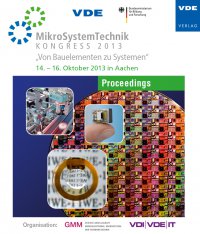MEMS based magnetoelectric field sensor characteristics under vacuum and after heat treatment
Konferenz: Mikrosystemtechnik 2013 - Von Bauelementen zu Systemen
14.10.2013 - 16.10.2013 in Aachen, Deutschland
Tagungsband: Mikrosystemtechnik 2013
Seiten: 4Sprache: EnglischTyp: PDF
Persönliche VDE-Mitglieder erhalten auf diesen Artikel 10% Rabatt
Autoren:
Lofink, F.; Marauska, S.; Claus, M.; Wagner, B. (Fraunhofer Institute for Silicon Technology (ISIT), Fraunhoferstr. 1, 25524 Itzehoe, Germany)
Jahns, R.; Knöchel, R. (High-frequency Laboratory, Institute of Electrical Engineering, Christian-Albrechts-University, Kaiserstrasse 2, 24143 Kiel, German)
Kirchhof, Ch.; Quandt, E. (Inorganic Functional Materials, Institute for Materials Science, Christian-Albrechts-University, Kaiserstrasse 2, 24143 Kiel, Germany)
Inhalt:
A 2-2-bilayer thin-film cantilever-type magnetic field sensor has been investigated. The composite system consists of AlN and the magnetostrictive material (Fe90Co10)78Si12B10 (metglas). It is observed that by vacuum operation of this device the limit of detection can be lowered by an order of magnitude from 3nT/Hz1/2 to 300 pT/Hz1/2 and the quality factor is enhanced by a factor of 11. Common vacuum encapsulations on wafer level require temperatures beyond 300deg C. In this context temperature stability of FeCoBSi is a key variable. At temperatures above 250deg C the magnetization loops starts to possess a hysteresis character. At 450deg C a clear hysteresis as well as FeCo(110) crystallization is detected. Up to 250deg C, temperature treatment improves the soft magnetic character and sensor performance of the device. This can be correlated with internal stress relaxation. By annealing the stress changes from compressive to tensile values with a stress-free state at approximately 250deg C.


